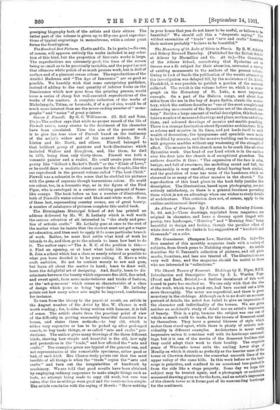The Monastery of St. Luke of Stiris in Phocis. By
R. W. Schnitz and Sidney Howard Barnsley. (Published for the British School at Athens by Macmillan and Co. £3 3s.)—The Committee of the Athens School, considering that Byzantine art ia Greece was a fit subject for their attention, entrusted a survey of existing monuments to the authors of the present volume. Owing to lack of funds the publication of the results attained by the investigation was delayed till, by the assistance of Dr. Edwia Freshfield, it was possible to publish a portion of the material collected. The result is the volume before us, which is a mono- graph on the Monastery of St. Luke, a most important example. On a part of the Helicon range, and about four miles from the sea in the bay of Aspra Spitia, stands the monas- tery, which the authors describe as "one of the most complete and interesting monuments of the Byzantine art of the eleventh cen- tury." Besides a large amount of verbal description, this book con- tains a number of measured drawings and plans, sections and eleva- tions, and coloured drawings of mosaics and marble panelling. There is a strange fascination about Byzantine architecture. It is so solemn and massive in its lines, and yet lends itself ta such wealth of decoration ; the tympanums and spandrils seem made to be filled by mosaics, and the massive building can be encrusted with gorgeous *marbles without any weakening, of the strength of effect. The mosaics in this church seem to be much like all other Byzantine work. One head cf our Lord which is in the narthsx over the door into the church is of exceptional grandeur. The authors describe it thus : "The expression of the face is calm, benign, and full of sweetness, the modelling round and full, the workmanship is very careful, every detail having been studied, and the gradation of tone has none of the harshness which we observed in so many of the other mosaics in the church." The reproduction of this head given in the book fully justifies this description. The illustrations, based upon photography, are not entirely satisfactory, as there is a general fuzziness pervading them which is not an advantage when one wishes to study details of architecture. This criticism does not, of course, apply to the outline architectural drawings.






































 Previous page
Previous page